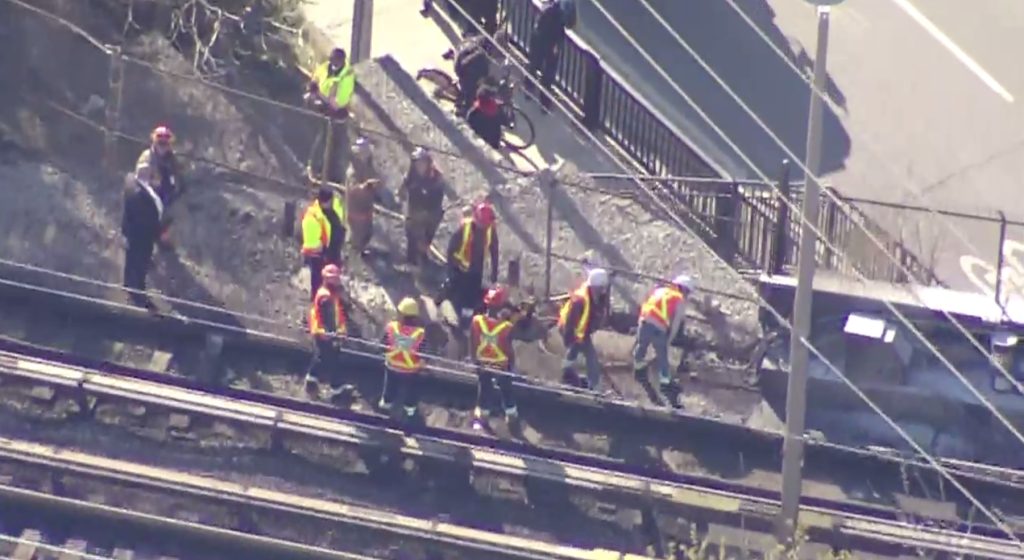Report Into Luge Death At 2010 Olympics Expected To Lay Blame On Many, Not One
Posted April 18, 2010 12:48 pm.
This article is more than 5 years old.
He had raced down the luge track more than two dozen times, but coming around the final curve on the morning of Feb. 12, something went wrong.
At Corner 16, Nodar Kumaritashvili’s sled went one way and he flew another, slamming into an exposed steel pole.
His goggles skittered down the icy track as he lay motionless beside it.
As medics rushed to the athlete’s side, John Furlong’s cellphone rang.
It was the opening day of the 2010 Olympics and Furlong’s mind was absorbed with the details of the ceremonies, of whether there would be enough snow for the next day’s events on Cypress Mountain and enough buses to get people to the events at all.
The call forced everything out.
There had been an accident on the luge track, the head of the 2010 Olympics was told. The athlete was unlikely to survive.
“I closed my door and had every emotion that you could possibly have,” Furlong said in a recent speech.
“Grief, and I was praying that the call would come back that he had survived and that he would make it and bad as it was, that we would get over it and move on.”
Then the second call came.
The 21-year-old luger from Georgia had died.
Now, more than two months after the accident, international sporting officials are set to release a report Monday into what happened in the moments before and between those two calls.
The international luge federation’s report is also seeking to answer the question of whether the accident that will forever mark the 2010 Winter Olympics with an asterisk could have been avoided.
The report is expected to address everything from the speed of the track itself to whether there was a problem with the luger’s sled.
What it won’t do is lay the blame for the incident on any single factor.
“Everybody wants a scapegoat and to say, ‘It was that person’ (to blame),” FIL secretary general Svein Romstad, the report’s lead writer, told The Associated Press earlier this month.
“I think one thing we will see is that it’s an amalgamation of a lot of different things. What happened to Nodar was very, very unique.”
Vancouver organizers, known as VANOC, helped FIL compile the report, their staffers providing reams of statistics on the track, training runs, the process of getting ready for the Games and all manner of other details.
Stunned by the crash and unsure even how to figure out what happened, FIL also relied on local police to help them reconstruct the event and those details are also expected to be released on Monday.
VANOC had been concerned the report would lay blame solely at their feet – they were responsible for building a track that was the fastest in the world.
The $104.9 million sliding centre was used for luge, bobsled and skeleton during the Games and was completed in 2007.
When it opened, veteran Canadian bobsledder Pierre Lueders took the first run down and found the track so fast his sled went airborne.
The gold-medal winner in luge at the Games, Felix Loch, clocked 154 km/hour during a test run of the facility.
Kumaritashvili had reached 145 kilometres an hour by the final fatal turn on the track.
He had run the track 26 times and he came into the Olympics ranked 44 out of 65 in World Cup standings.
Still, the report will examine how he met FIL’s standards and other athletes have said they hope it also reviews training access and procedures for the sport.
Kumaritashvili’s family, which has long ties to the sport of luge, will also be given a copy.
A luge track is under construction in their town of Bakuriani, Georgia and FIL has been carrying out a fundraising campaign to help the family.
On Friday, the Vancouver Board of Trade announced it was donating $10,000 to the effort.
Furlong said he hadn’t seen a copy of the report yet but believed it would be thorough.
“Things happen in winter sports, it’s very fast and I think anything that sport does that tries to reduce the possibility of catastrophic injury or death is work we should be doing all the time,” he said.
“I think that’s a good thing and I suspect there will be some of that in there. There should be.”
Initially, the Georgian’s accident was attributed to driver error and that will still be one factor raised in the report.
After the accident, officials moved down the starting point for the men’s competition and covered the pole, despite repeatedly stressing the track was safe.
A decision has already been made to try and slow the sport down.
Officials preparing for the 2014 Olympics in Sochi Russia have promised their track would be built for speeds of less than 135 kilometres an hour.
The post-Games life of the Whistler track is in the hands of the Whistler 2010 Sports Legacies Society which is managing the sliding centre, Nordic centre and athletes centre left in the resort mountain town by the Games.
It’s supposed to host the 2013 World Luge Championships and also be used as a training facility for Canadian and international athletes.
FIL has committed to keeping their event on the track in 2013.










